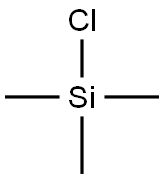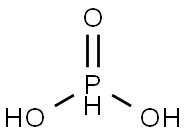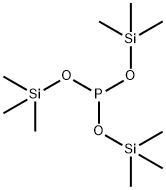
BIS(TRIMETHYLSILYL) PHOSPHITE synthesis
- Product Name:BIS(TRIMETHYLSILYL) PHOSPHITE
- CAS Number:3663-52-3
- Molecular formula:C6H19O3PSi2
- Molecular Weight:226.36

75-77-4
576 suppliers
$5.04/10

3663-52-3
19 suppliers
inquiry
Yield:3663-52-3 98.8%
Reaction Conditions:
with phosphonic Acid;N-benzyl-N,N,N-triethylammonium chloride;tetra(n-butyl)ammonium hydrogensulfate;formamide at 20 - 27; for 2.5 h;Inert atmosphere;Reagent/catalyst;Temperature;
Steps:
4 Example 4
The humidity of the operating room is controlled at 35% -45% and the temperature is about 25 .First, the phosphorous acid is subjected to a water removal operation, and phosphorous acid and toluene are placed in a vessel, and the oil bath is heated and refluxed,Treatment for 4h, remove the water, steamed concentrated toluene (water pump, vacuum 0.095MPa, temperature 60 ) concentrated to 2h to constant weight, get water after the addition of phosphorous acid.Weigh 29.2 g (0.356 mol) of dephosphoric acid and 90 mL of formamide (102 g) were added to 500 mL of fourBottle, the access to nitrogen, control the flow rate of nitrogen 5ml / min, stirring for about 15min, the full melting of phosphorous acid, the colorless transparent liquid, continue to pass nitrogen, exhaust 20min.To this colorless transparent liquid was added dropwise 180 mL (152 g, 1.4 mol) of trimethylchlorosilane (slightly brown) to control the dropwise additionThe speed was 0.012 mol / min, the drip rate was faster, and the mass ratio of 7.6 g of benzyltriethylammonium chloride and tetrabutylammonium bisulfate (benzyltriethylammonium chloride and tetrabutylammonium hydrogen sulfate 1: 0.6), the reaction has an exothermic phenomenon,The temperature rises, there is hydrogen chloride release, ice bath cooling. The entire reaction process control temperature is less than 27 , with hydrogen chloride release,The reaction solution becomes white mucus. The nitrogen cylinder directly connected to the reaction bottle, increase the gas velocity (control the flow rate of nitrogen 7ml / min) can be the product gas hydrogen chloride blowing, the pH test paper for the acidic. The study found that the gas speed can not be too large, otherwise the hydrogen chloride emissions are too large, serious pollution; gas speed over the General Assembly will affect the reaction, reduce the yield, but also affect the purity. Stir the mixture for a while, the reaction layer was layered, the upper layer was a pale yellow product, and the lower layer was a white turbid solution of formamide and potassium chloride.Trimethylchlorosilane is added dropwise, the reaction solution is blurred under vigorous stirring, and the stirring is stopped.The temperature gradually decreased, stirring at room temperature for 2.5h, by-product hydrogen chloride gas kept blowing. The reaction ends.Add 150 mL of petroleum ether to the reaction flask and stir for 10 min (to prevent water vapor) and transfer to 1000 mL single mouthBottle. Then add 320mL petroleum ether stirring 20min and then into the separatory funnel, layered obvious, standing for 15min (the petroleum ether and formamide completely separated). (Vacuum) 0.095MPa, 38mmHg, temperature 50 ), concentrated 1.5h to constant weight, the product 104.5, the yield of 98.3%, the gas chromatograph (GC) was added to the petroleum ether layer by adding 23g anhydrous sodium sulfate and dried for 8min. The detection purity was 98.6%. Placed in self-styled bags (pre-installed anhydrous calcium chloride and discolored silica gel) and placed in a dryer to save.To the above product (crude crude bis (trimethylsilyl) phosphite) was added 0.11 g of ChimassorbThe product was purified by distillation under reduced pressure, and finally 103.2 g of product was distilled off to obtain purified bis (trimethylsilyl) phosphite in a yield of 98.8%. The purity was 99.95% by gas chromatography.
References:
CN106866728,2017,A Location in patent:Paragraph 0020-0044; 0045; 0046; 0047; 0048-0052

999-97-3
643 suppliers
$9.00/5G

3663-52-3
19 suppliers
inquiry



